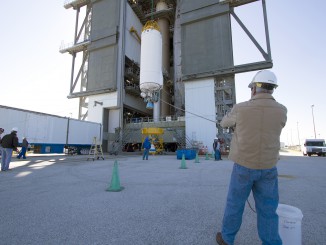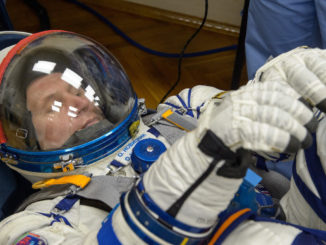TORONTO – Officials working on India’s Mars orbiter project are finalizing plans for a six-month science campaign after the spacecraft arrived in orbit last week, an achievement that has already satisfied the mission’s primary objectives, the head of India’s space agency said Monday.
Since the probe entered orbit around Mars, scientists have switched on four of the craft’s five scientific instruments and the orbiter has returned dazzling images of the red planet, showing Martian surface, atmosphere and an uncommon global perspective rivaling views from the Hubble Space Telescope.

The Mars Orbiter Mission, developed and launched for $74 million, was conceived as a technological trailblazer for India’s interplanetary exploration program.
The mission is India’s first robotic probe to travel beyond the moon, and the craft’s arrival at Mars made India the fourth entity to put a satellite into orbit around the red planet.
“It was an historic moment for everyone in the country,” said K. Radhakrishnan, chairman of the Indian Space Research Organization. “It was a technological mission primarily, and have we achieved that. We give ourselves an 85 percent mark for that achievement.”
Speaking at the 65th International Astronautical Congress, Radhakrishnan said officials are now developing a flight plan for the first six months of the Mars orbiter’s mission at the red planet.
“We are working out what could be the possible observational plan, and at least six months of that plan is going to be developed soon,” Radhakrishnan said.
With four of the MOM spacecraft’s five sensors already activated since it arrived at Mars, scientists are looking forward to sharing data with U.S. scientists under an agreement signed Tuesday by Radhakrishnan and NASA Administrator Charlie Bolden.
The charter signed by the two space agency chiefs here sets up a joint Mars working group to explore future collaboration between the United States and India on future missions to the red planet.
One of the first tasks of the working group will be to explore potential coordinated observations and science analysis between MOM and NASA’s MAVEN spacecraft, which entered orbit at Mars on Sept. 21, according to a NASA press release.
The Indian Mars mission carries a color imaging camera to return medium-resolution pictures of the Martian surface, a thermal infrared spectrometer to measure the chemical composition of rocks and soils, and instruments to assess the Mars atmosphere, including a methane detector.
Scientific assessments of methane in the Martian atmosphere have returned mixed results.
Methane is a potential indicator of current microbial life on Mars, but some types of geologic activity can also produce trace levels of the gas.
The MOM probe’s color camera has already snapped several images of Mars.
The Indian Mars mission’s cost, about one-tenth of cost of NASA’s MAVEN atmospheric research orbiter, has gained attention and drawn scrutiny.
Officials have cited lower labor costs in India as one factor in the cost differential.
Radhakrishnan addressed several other reasons for India’s successful mix of engineering excellence and frugal spending behind the Mars probe.
Engineers recycled components and technologies used on other Indian satellites, and ISRO opted to launch the Mars mission on the proven Polar Satellite Launch Vehicle, India’s smaller rocket which could not propel the probe directly toward Mars.

The PSLV placed the MOM spacecraft into orbit around Earth, then the craft used its own thrusters to escape Earth’s gravity and fly to Mars.
“We replaced a very powerful launch vehicle system through this novelty,” Radhakrishnan said. “In that process, we also checked out all autonomy that we had to put on the satellite.”
The Mars project follows India’s Chandrayaan 1 lunar orbiter launched in 2008.
“The second philosophy that we follow in India — in ISRO — is modularity, that is we take from one vehicle a proven subsystem and add it to the next vehicle or satellite system,” Radhakrishnan said.
Around-the-clock preparations ensured the mission was ready for launch in a narrow window in November 2013, when Earth and Mars were properly positioned to make the journey possible
“The time [to develop MOM] was four years, and there were people working almost on a 24-by-7 basis,” Radhakrishnan said. “We did not compromise on any tests.
“I would say modularity is one major reason for the cost reduction and the time reduction, and of course people putting all their might to ensure that the [mission was ready] for the first available opportunity in 2013.”
Despite the mission’s low-budget background, MOM’s successful orbit insertion made India the first country to ever succeed at a Mars mission on its first try.
With the craft’s arrival at the red planet, India joins the United States, Russia and the European Space Agency in successfully sending robotic missions to Mars.
Accustomed to critics who question the value of a space program in a country facing chronic poverty and widespread sanitation issues, ISRO’s main focus is on space missions with direct applications to Indian citizens.
“Space’s benefit to the people is our main priority,” Radhakrishnan said. “Spinoffs need to trickle down.”
India boasts a fleet of nearly two dozen satellites providing communications services for telemedicine, long-distance education and information dissemination, monitoring weather and climate, and helping authorities respond to natural and man-made disasters.
ISRO has also attracted foreign business in launching international satellites on the Polar Satellite Launch Vehicle.
A fleet of Indian navigation satellites will improve GPS services over the Indian subcontinent, and India is building the world’s most high-resolution civilian-operated Earth observation spacecraft.
India’s future space science missions include the Chandrayaan 2 moon lander and rover, an X-ray astronomy satellite, and a solar research probe planned to operate at the L1 Lagrange point a million miles from Earth.



